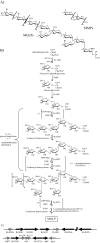Polymethylated polysaccharides from Mycobacterium species revisited
- PMID: 18786916
- PMCID: PMC2629103
- DOI: 10.1074/jbc.R800047200
Polymethylated polysaccharides from Mycobacterium species revisited
Abstract
Mycobacteria produce two sets of unusual polymethylated polysaccharides, the 3-O-methylmannose polysaccharides and the 6-O-methylglucose lipopolysaccharides. Both polysaccharides localize to the cytoplasm, where they have been postulated to regulate fatty acid metabolism due to their ability to form stable 1:1 complexes with fatty acyl chains. Physiological evidence for this assumption is lacking, however. Recent advances in our knowledge of the processes underlying sugar transfer in mycobacteria, together with the availability of genome sequences and tools for the genetic manipulation of these microorganisms, have opened the way to the elucidation of the biosynthetic pathways and biological functions of these unique carbohydrates.
Figures


References
-
- Berg, S., Kaur, D., Jackson, M., and Brennan, P. J. (2007) Glycobiology 17 35R–56R - PubMed
-
- Lee, Y. C., and Ballou, C. E. (1964) J. Biol. Chem. 239 PC3602–PC3603 - PubMed
-
- Lee, Y. C. (1966) J. Biol. Chem. 241 1899–1908 - PubMed
-
- Gray, G. R., and Ballou, C. E. (1971) J. Biol. Chem. 246 6835–6842 - PubMed
-
- Hunter, S. W., Gaylord, H., and Brennan, P. J. (1986) J. Biol. Chem. 261 12345–12351 - PubMed
Publication types
MeSH terms
Substances
Grants and funding
LinkOut - more resources
Full Text Sources

